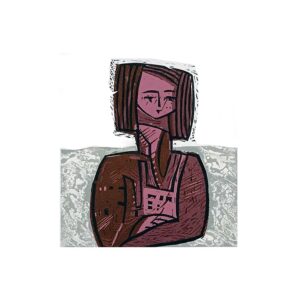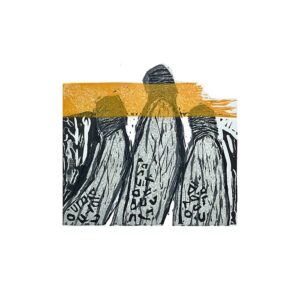ART OF ARIF ZIYA TUNC
Artists prefer to use the techniques they find most appropriate as means of expression in their artistic creations. Regardless of their technical preferences, the plastic and aesthetic elements (shape) that a work of art should carry and its content determine the artistic value of that work. As in painting and sculpture, this is undoubtedly true in printmaking. Arif Ziya Tunç’s preference is also in printmaking.
Tunç first encountered printmaking in his high school years. The journey he began by learning this art from his art teacher deepened when he became a student of Mürşide İçmeli, one of Türkiye’s leading printmaking artists, during his university years. This was a great opportunity for him. İçmeli’s style and stain approach deeply influenced Tunç.

One of the advantages of receiving a university education in Ankara was the opportunity to access many exhibition halls. These exhibitions made significant contributions to the development of creativity, visual thinking and sense of style. Especially the exhibitions coming from abroad were like a school and a visual treasure for him. During his student years, he carefully observed the printmaking of contemporary German, English, French and Belgian artists. Movements such as German Abstract Expressionism, Bauhaus and New Typographic Style were decisive in the formation of his understanding of art.
During his art education at Gazi Education Institute, he produced numerous prints. He almost rested while working in the studio. The anecdote, “Since he worked until morning and went to bed late, he would often be late for the first lesson, but when Mürşide Hoca saw the prints hanging on the wall to dry, she would understand the situation and tolerate it,” shows his passion for this branch of art. While still a student, in 1973, he managed to participate in the Competitive State Printmaking Exhibition for the first time with one of his works. He expresses the excitement of this success as follows: “When I saw the word ‘Artist’ on the envelope brought by the postman, I grabbed the envelope from his hand and ran to my father with joy.” The artist regularly participated in these juried exhibitions in the following years and won the “State Achievement Award” twice. His interest and enthusiasm for printmaking never waned. Today, he continues to work in his own studio.

Tunç produced works in almost all printmaking techniques. However, he was more excited by engraving, linoleum and woodcut techniques. He pushed high printing techniques and produced prints that drew attention with their simple but strong stain, form and color values. For a while, he focused only on black and white series. The reasons for his preference for black and white include the strong structure and dynamism provided by the contrast, the natural structure of the material, the richness of texture and the opportunity to work spontaneously. Although contrasts such as black and white, plus and minus, hot and cold, night and day seem to reject each other, their existences are mutually interconnected. When we consider that his understanding and style of art is based on a formalist and stainist approach, it becomes immediately clear how important black and white is. This approach undoubtedly does not change in his color prints. Color is superficial and supports form. Transforming objects from form to form by depriving them of the outside world and light, combining layers of images on a surface without depth and abstraction constitute his style. Addressing external reality with an internal orientation and an expressive language constitutes the basic movement in his prints. This is like a result of this visual orientation. The harmony and order of the stain and formal values also show an internal orientation that reflects our position in relation to the external world. In this context, what he seeks in his art is primarily balance. While opposing elements clash with each other, they also create balance, dynamism and excitement.
Every work of art contains semiotic codes (symbols) belonging to the world of thought. These visual codes, which consist of tensions (relationships) between objects, provide perception regarding the presented work. Oppositions (relationships) take on a role that facilitates the perception of this visual coding and clarifies the subject that is intended to be explained. Another function of this opposition is to add excitement to the content due to its internal dynamism originating from the plot. The balanced-oppositions in his prints present the possibilities of free thought to the viewer by making certain associations thanks to the relationships established by the elements that make up the work.
As a printmaking artist, he produces works in his field, but he believes that this artistic medium of expression is still not sufficiently recognized in our country. He lists the difficulties that artists have in finding paper and printing inks and the fact that it is not considered valuable by collectors among the many reasons for this. Another important issue is the problem of creating a sufficient workshop. Tunç states the following about the workshop: “Printmaking is a form of artistic expression that requires comprehensive and technical equipment. A workshop must have tools and equipment such as an engraving press, drying shelves, paint and paper cabinets, ventilation systems, suitable lighting, mains water and sinks, acid tubs, large tables for mold preparation and paper cutting. Due to the difficulty of creating these, it is natural that the number of printmaking artists in Turkey is low and therefore not sufficiently recognized.”
According to Tunç, an artist cannot be considered separate from the society he lives in. He has a worldview according to the structure of the society he is in. Therefore, social events, life and culture determine his understanding of art. As an artist, he believes that he contributes to the development of our social consciousness by merging with the culture coming from our history and presenting the values that make up our culture to the audience with an abstract-expressionist approach, and defines himself as a “Culture Carrier”. Traces of our culture can be seen in his prints created with an abstract-expressionist style. Although the images create an abstract impression at first, they soon become concrete in the mind of the audience and gain meaning by integrating with his own past.”
